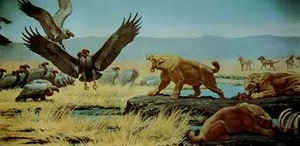Washington State Fossil
Columbian Mammoth

(Mammuthus columbi)
Adopted in 1998.
Washington's newest state symbol is the Columbian mammoth, (Mammuthus columbi.) Students from Windsor Elementary School near Cheney led a four-year effort to have this behemoth designated as our state fossil in 1998. Mammoth is the common name given to any member of an extinct genus Mammuthus of the elephant family.
Washington State Fossil: Columbian Mammoth

The Columbian Mammoth, (Mammuthus columbi, ) was a descendent of (Mammuthus meridionalis,) the ancestral mammoth that entered North America via the Bering Land Bridge about one million years ago. The Columbian mammoth ranged from Alaska, and the Yukon, across the mid-western United States south into Mexico and Central America.
Nearly all mammoths died out about 10,000 years ago. Two species of mammoths, the Columbian and woolly, were trapped in the Hot Springs Mammoth Site pond.
The Columbian Mammoth (Mammuthus columbi) was the largest mammal to have been trapped in the La Brea Tar Pits. Some individuals stood over
13 feet tall. The Columbian Mammoth was larger, but less hairy, than the wooly mammoth which lived near the ice sheets in the northern end of the continent.
The mammoth became extinct about the same time the first humans migrated into North America.
The extinct Columbian mammoth was one of the largest elephants to have walked the Earth. It had impressive, spiralled tusks which measured up to 4.9m
(16ft) long, making them world record holders amongst the elephant family.
Characteristics of the Columbian Mammoth

TIME - Late Pliocene to Late Pleistocene
Statistics
13ft tall at the shoulder and up to 10 tons in weight.
Physical Description
One of the largest elephants ever to have lived, the Columbian mammoth was like a large African elephant but with a more sloping back and long, spiralled
tusks. One tusk from a mammoth found in Texas had a tusk measuring 16ft, the longest of any of the elephant family. Huge, standing almost 14 foot at
the shoulder (420 cm), and weighing 8-10 tons. The males grew to the size of modern adult elephants. The females were about half the size of the males.
There is some debate as to how much hair the Columbian mammoths had and some scientists suggest that they had a full fur coat like the woolly mammoth.
It is more likely that hair grew more extensively on some parts of the body, such as the top of the head, but that they were basically elephant-like
with exposed naked skin, greyish in color.
Distribution
Columbian mammoths ranged through the southern half of North America and south into Mexico (south of the ice sheets).
Habitat
Columbian mammoths were widespread throughout grasslands and woodlands.
Diet
Mammoths were herbivores eating mainly grasses and other low growing plants. They also browsed on leaves, twigs and fruit.
Behavior
Social life revolved around the female herds, with groups of related individuals staying together throughout their lives. Such herds would have numbered
between 2-20 individuals, were led by a dominant matriarch and comprised a number of other adult females and their offspring. Female young would stay
with the herd while males would leave when they reached 12-15 years of age.
Reproduction
Gestation was 22 months, after which a single young was produced and suckled until 2-3 years old. Adult males lived apart from the herds, joining them
only during the breeding season to mate with receptive females. Adult males would have fought for access to the female herds at this time
Conservation status
Columbian mammoths became extinct approximately 12,500 years ago.
History
The Columbian mammoth was a uniquely American species which evolved from an ancestor that colonized the New World about 1.5 million years ago. In Eurasia,
this same ancestor evolved separately into the woolly mammoth.
Revised Code of Washington (RCW)
The law designating the Columbian mammot as the official Washington state fossil is found in the Washington Statutes, Title 1, Chapter 1.20, Section 1.20.042.
Chapter 1.20 RCW
Title 1 GENERAL PROVISIONS
RCW 1.20.042
State fossil.
The Columbian mammoth of North America, Mammuthus columbi, is hereby designated as the official fossil of the state of Washington.
[1998 c 129 § 2.]
NOTES:
Legislative recognition - 1998 c 129: "The legislature recognizes that the large, hairy prehistoric elephants of the extinct genus Mammuthus roamed
the North American continent, including the Pacific Northwest, during the Pleistocene epoch (ice ages)." [1998 c 129 § 1.]
Taxonomic Hierarchy: Columbian Mammoth
Kingdom: AnimaliaPhylum: Chordata
Class: Mammalia
Order: Proboscidea
Family: Elephantidae
Genus: †Mammuthus
Species: †M. columbi
Binomial name: Mammuthus columbi (Falconer, 1857)

Some states that lack a "state fossil" have nevertheless singled out a fossil for formal designation such as a state dinosaur, rock, gem or stone.







